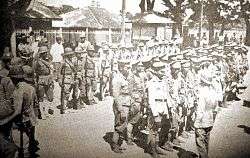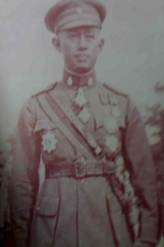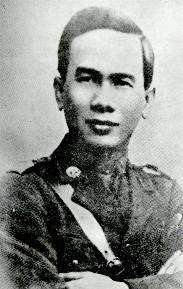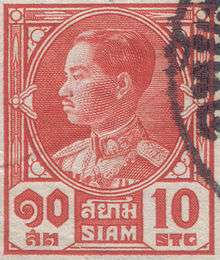Boworadet Rebellion
| Boworadet Rebellion | |||||||
|---|---|---|---|---|---|---|---|
 Siamese soldiers during the rebellion | |||||||
| |||||||
| Belligerents | |||||||
| Prince Boworadet and Allies | Royal Siamese Government (Khana Ratsadon) | ||||||
| Commanders and leaders | |||||||
|
Prince Boworadet Sri Sitthi Songkhram |
Luang Phibulsonggram Luang Amnuai Songkhram Phraya Phahol Phon Phayuhasena | ||||||
The Boworadet Rebellion (Thai: กบฏบวรเดช; rtgs: Kabot Boworadet; [kà.bòt.bɔ̄ː.wɔ̄ː.rá.dèt]) was a Thai rebellion (or unsuccessful coup d'état) led by royalist Prince Boworadet in 1933, in consequence of the conflicts between the previous royalist regime and the succeeding constitutional regime following the Revolution in 1932. The Boworadet revolt was eventually defeated by the Siamese Government. As a historical event it was cataclysmic in the transformation of Thai politics and government.
Background

In March 1933, Pridi Phanomyong, a Minister of State and a member of the People's Party, was attacked verbally by the constitutional monarch King Prajadhipok (or King Rama VII) as a communist following the proposal of the Draft National Economic Development Plan, or the Yellow Cover Dossier, to the National Assembly. The Yellow Paper was a plan to arrange and provide State welfare, to distribute all land to the rural poor, to interfere in economic affairs of the private sectors and to provide rural farmers more economic subsidies. These concepts were deemed communistic (or at least socialistic) by the Monarch. This led Thawan Ritthidet (Thai: ถวัลย์ ฤทธิเดช), a private citizen, to file a lawsuit against the King, accusing him of intervention in political, state and economic affairs. The fallout over Pridi's plan divided the Cabinet and led the Prime Minister, Phraya Manopakorn Nititada, to dissolve the National Assembly on the 1 April and use emergency decrees (such as the Anti-Communist Act) to govern. Pridi was immediately exiled to France.
On the 20 June, a senior Army Officer and member of the Khana Ratsadorn or the People's Party, General Phraya Phahon Phon Phayuhasena (Thai:พลเอก พระยาพหลพลพยุหเสนา (พจน์ พหลโยธิน)), seized power in a coup d'état, overthrowing the Government of Phraya Manopakorn. The coup leader appointed himself the second Prime Minister of Thailand, declared Pridi Phanomyong not guilty and allowed him to return.
Prince Boworadet

Prince Boworadet (Thai: พระเจ้าบรมวงศ์เธอ พระองศ์เจ้าบวรเดช), a German-educated minor member of the Royal Family, had been Minister of Defense and the Siamese Ambassador to France. He lost his positions following the Revolution of 1932. An ardent royalist, he was furious that anyone was allowed to sue the King. This added to his discontent of Phraya Phahon Phon Phayuhasena's coup against Phraya Manopakorn and his support of Pridi against the monarch.
Prince Boworadej secretly plotted with Colonel Phraya Sri Sitthi Songkhram (Thai: พระยาศรีสิทธิ์สงคราม), commander of the Armed Forces of Bangkok, and other senior military officers to stage a coup d'état to unseat the government and replace it with a more traditional one. When the Khana Ratsadon (People's Party) took over, the older right-wing military officers had been unceremoniously pushed out and replaced by younger coup members.
On 11 October 1933, Prince Boworadet led royalist forces from the Eastern Region of the Country, consisting of the Korat, Phetchaburi, and Udon Regiments, together with a cavalry unit and several artillery batteries. They reached the capital to find that the military units in Bangkok supported the government. He nevertheless continued the attempt.
Defeat of the Rebellion
The first clash occurred on 11 October 1933 at Amphoe Pak Chong, in Nakhon Ratchasima Province. The government forces were defeated and several members of the government were captured. The rebels then marched to Bangkok's Khet Don Mueang, calling themselves the National Rescue Council (Thai: คณะกู้บ้านเมือง; RTGS: Khana Ku Ban Mueang) and their attempt the Deer Plan (Thai: แผนล้อมกวาง; RTGS: Phaen Lom Kwang). Prince Boworadet tried to persuade other forces to join him, including the Royal Thai Navy, which instead declared itself neutral and sailed for bases in the South.
The legitimate government as it declared appointed Lieutenant Colonel Luang Phibulsonggram, one of the 1932 coup makers, to command the Bangkok forces. These were supported by an armoured car and a tank commanded by Pibun's friend, Lieutenant Colonel 'Luang Amnuai Songkhram (Thom Kesakomon) (Thai: หลวงอำนวยสงคราม (ถม เกษะโกมล)), who would later be killed in combat.

After a day of fierce fighting on 12 October, the rebels were able to capture Don Muang on the outskirts of the city. Major Luang Seri Somroeng Rit (Thai: พันตรีหลวงเสรีเริงฤทธิ์) was appointed (under truce) to ask the rebels to surrender, under a government offer of amnesty. However, the Major was seized and made a hostage. The rebels presented the following demands:
- 1) the Country shall be headed by the King forever;
- 2) all State affairs must be carried out in accordance with the Constitution, especially the appointment and removal of a member of the Council of Ministers, which can only be made by a majority of votes;
- 3) Permanent public officials, both civil and military, shall not intervene in politics;
- 4) The appointment of public officials shall be made with regard qualifications, without political partiality;
- 5) The second type (non-elected)of the people's representatives shall be appointed by the King (as opposed to the Prime Minister);
- 6) Armaments for the Army shall be provided everywhere, not gathered in any specific area;
- 7) Amnesty shall be granted to the National Rescue Council and all its supporters.
The legitimate government in Bangkok refused to comply with their demands, and the rebel forces advanced further to the capital, seizing the area around Bang Khen. The rebels set up a stronghold near the Lak Si train station, using machine guns and cavalry. The government was able to drive the rebels with the help of the Nakhon Sawan Regiment and a declaration of the Prachinburi Regiment in support of the government and join the fight. This broke the rebels' morale, and on 14 October they began to retreat. The next day the government with superior forces (heavy artillery having been moved in by rail) was able to attack the rebel stronghold. Running out of ammunition and supplies, the rebels broke. Government forces pursued and advanced to the rebel base in Nakhon Ratchasima. On 23 October, with the possibility of further reinforcement by other provincial garrisons and the death in action of Boworadet's second-in-command, Phaya Sri Sitthi Songkram, the rebels were badly defeated. The remnants dispersed, and the royalist revolt was over.
Aftermath
Much destruction was done to the infrastructure of Bangkok (railways and bridges) and the surrounding area, including the Don Mueang Aerodome, from artillery bombardment, bombings and fire. On 25 October Prince Boworadet and his wife boarded an aeroplane and left Siam for Vietnam (then part of French Indochina). Many other leaders were arrested or surrendered, including Prince Boworadet's younger brother, Prince Sinthiphorn Kadakorn (Thai: หม่อมเจ้าสิทธิพร กฤดากร). The rest were eventually suppressed and were tried by a special court. Many received life sentences, but none were executed. Most sentences were later reduced and many were pardoned completely. Prince Boworadet received asylum in Cambodia, where he lived until 1948. He then returned home to Thailand, dying in 1953 at the age of 76.
Legacy

Phraya Phahol's Government was able to further cement their grip on power. Although no direct evidence that Prajadhipok ever supported the rebellion, the result was nevertheless a blow to the King, as the rebels had claimed to be fighting in his name. His prestige was greatly diminished and his power severely weakened. The King's lack of leadership and indecisiveness showed when he only released a telegram saying that he regretted the strife and civil disturbances that occurred, he and the Queen then left the capital for Songkla leaving the Government to deal with the rebellion. During this time he also failed to support his constitutional Government, which undermined his credibility and his perceived commitment to democracy and the constitutional system. This gave Phraya Phahol and the King's opponents reason to point that the monarch has failed to do his duty. The series of events following the rebellion eventually led to the King's abdication in 1935. The rebellion also led to the estrangement of the aristocratic factions and families, which has served the Kingdom for centuries. They were viewed with distrust and would never again regained their power and position in Thai politics.
The rebellion was also seen as a beginning of the meteoric rise of the two key players in the rebellion: Pridi and Phibul. Pridi, eventually became leader of the civilian faction within the Government and later Regent for King Ananda Mahidol (or Rama VIII) from 1944–1946 and then eventually Prime Minister in 1946. Phibul became the new leader and hero of the military faction and replacing Phraya Phahol as Prime Minister from 1938–1944 and then later 1948–1957, and eventually de facto dictator of Thailand (to date the longest serving Prime Minister in Thai history).
The Rebellion Suppression Monument was established at Khet Lak Si, Bangkok, as a commemoration of this event, and later renamed as the Constitution Defense Monument.
See also
- History of Thailand (1932-1973)
- Phot Phahonyothin
- Plaek Pibulsonggram
- Prajadhipok
- Pridi Phanomyong
- Siamese Revolution of 1932
- Siamese coup d'état of 1933
- Sri Sitthi Songkhram
References
- (Thai) นายหนหวย (ศิลปชัย ชาญเฉลิม), เจ้าฟ้าประชาธิปก ราชันผู้นิราศ, โรงพิมพ์วัชรินทร์, 2530
- (Thai) ม.จ. พูนพิศมัย ดิสกุล, สิ่งที่ข้าพเจ้าได้พบเห็น (ภาคต้น), สำนักพิมพ์มติชน, พ.ศ. 2543
- (Thai) โพยม โรจนวิภาต (อ.ก. รุ่งแสง), พ. ๒๗ สายลับพระปกเกล้า พระปกเกล้าฯ (ฉบับพิมพ์ครั้งที่ ๒) พ.ศ. 2547